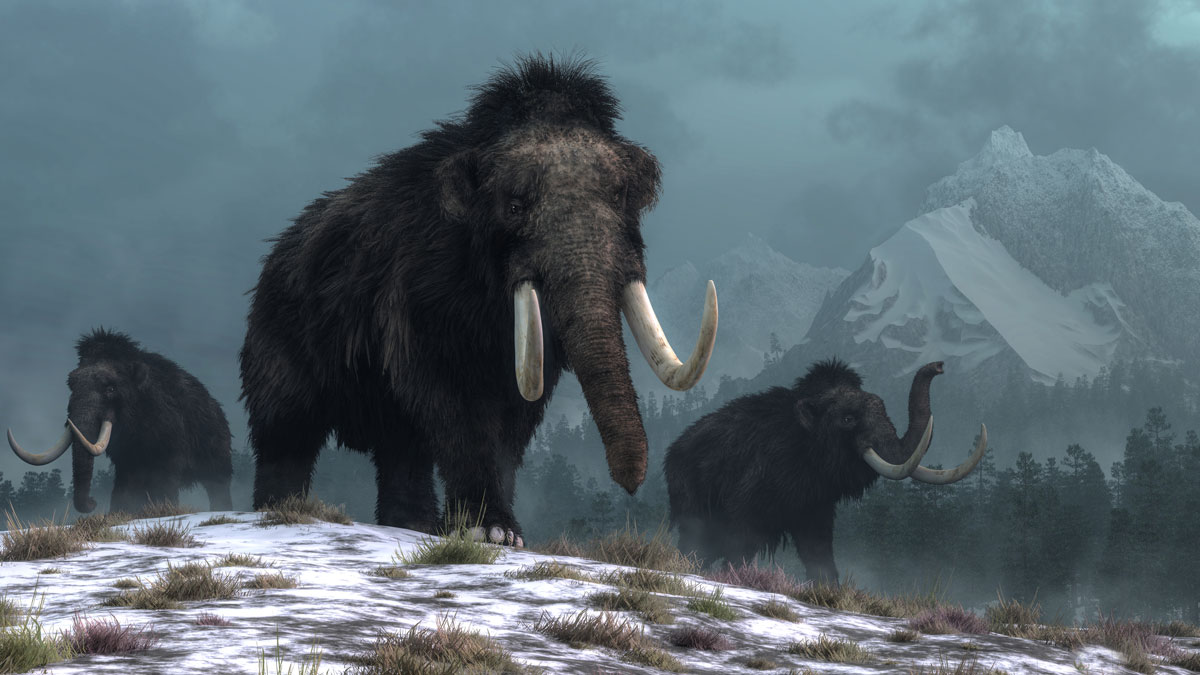About 25,000 years ago, Earth’s largest land biome—the “mammoth steppe”—began to disappear. Throughout the Last Glacial Period, commonly called the last ice age, the Arctic was wreathed in a vast grassland that supported as much animal and plant life as today’s African savanna. The ecosystem hosted extinct megafauna like mammoths and woolly rhinos and, at its greatest extent, spanned from Iberia to eastern Siberia and across the Bering Strait into Alaska and Canada.
Today, the mammoth steppe no longer exists. As the planet thawed, it vanished—though not without a trace.
Today, the mammoth steppe no longer exists. As the planet thawed, it vanished—though not without a trace.
Using ancient animal and plant environmental DNA (eDNA) extracted from sediments across the Arctic, scientists reconstructed a 50,000-year history of this lost ecosystem and published their findings in Nature. Not only do the new data show that mammoths were able to persist in small pockets of the mammoth steppe in Siberia for thousands of years longer than previously thought, but the findings also implicate climate change—not overhunting by ancient humans—in the loss of the biome and in the extinctions of Pleistocene megafauna.
“[Sediment eDNA] is a game changer,” said biogeoscientist Marc Macias-Fauria of the University of Oxford who was not involved in the new study. “It allows new questions or old questions to be answered in a different way.”
50,000 Years of Arctic Ecosystem Change Preserved in DNA

To peer back in time, researchers sequenced snippets of eDNA from hundreds of Arctic sediment samples collected over more than 20 years. They then aligned these eDNA sequences against more than 1.4 million genomes, including those of Arctic animals and plants, to determine which organisms the eDNA originally belonged to.
This effort was made possible by a massive new data set of 1,541 new plant genomes, which allowed the researchers to identify significantly more eDNA than they previously could have, said Arctic botanist and study coauthor Inger Greve Alsos of the Arctic University of Norway.
Along with these eDNA data, the researchers used a computational model of the past biome’s climate and the distribution of prehistoric humans across the Arctic. Together the model and the eDNA data revealed how animal and plant populations shifted as humans moved north and the globe thawed going into the Holocene. The analysis showed that vegetation across the Arctic shifted as the climate changed.
“When the climate becomes warmer in the Holocene, the vegetation in different regions starts to become different,” said paleoecologist Yucheng Wang of the University of Cambridge and University of Copenhagen, the study’s lead author. “For example, in the North Atlantic…we see aquatic plants increase dramatically immediately after the warming, while in central Siberia, which is more continental, we see that the steppe vegetation maintained basically unchanged.”
Climate Extinction or Human Overkill?
The eDNA from herbivores like mammoths tended to be absent from samples with more eDNA from woody plants and aquatic plants and from samples that the climate model associated with greater and more seasonally intense precipitation. This finding could indicate that the wetter Holocene climate allowed marshes, lakes, and forest to encroach on steppe vegetation, leaving large herbivores like mammoths without a suitable habitat. This interpretation placed the new results on one side of a long scientific debate on the nature of the mammoth steppe and the cause of the megafauna extinctions.
New research has “definitely added some very robust evidence into this debate to support that climate change was the driver for the last late Quaternary extinction.”
An alternative theory is that the mammoth steppe disintegrated because humans overhunted the large herbivores—what researchers sometimes call the human overkill scenario. The new data, however, didn’t show much evidence for overkill. Unlike vegetation and precipitation, the presence of ancient humans was almost completely unrelated to the eDNA-based distribution of most herbivores—including mammoths—across the Arctic. What’s more, the researchers found that mammoths survived in parts of Siberia until as recently as 4,000 years ago. Not only was this longer than previously thought, but the finding also suggested that humans coexisted with megafauna for thousands of years without overhunting them.
Although the debate about the fate of the mammoth steppe and the definitive cause of megafauna’s extinction is not over, this research “definitely added some very robust evidence into this debate to support that climate change was the driver for the last late Quaternary extinction,” Wang said.
—Elise Cutts (@elisecutts), Science Writer
This news article is included in our ENGAGE resource for educators seeking science news for their classroom lessons. Browse all ENGAGE articles, and share with your fellow educators how you integrated the article into an activity in the comments section below.


